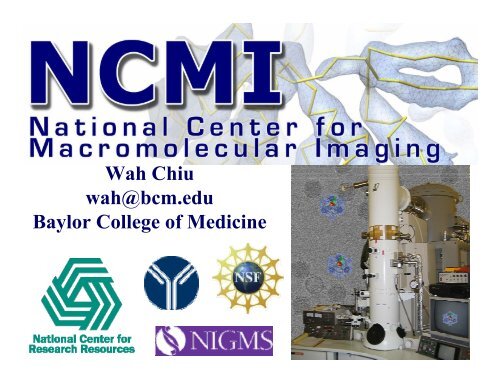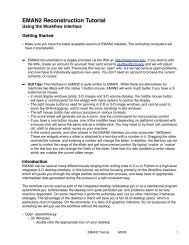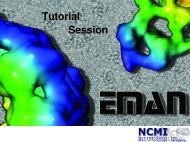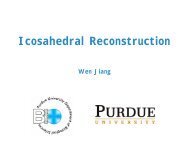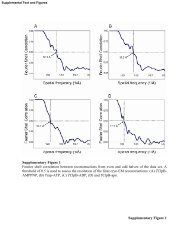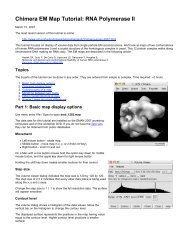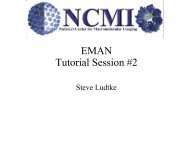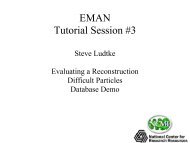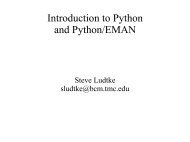Wah Chiu wah@bcm.edu Baylor College of Medicine
Wah Chiu wah@bcm.edu Baylor College of Medicine
Wah Chiu wah@bcm.edu Baylor College of Medicine
You also want an ePaper? Increase the reach of your titles
YUMPU automatically turns print PDFs into web optimized ePapers that Google loves.
<strong>Wah</strong> <strong>Chiu</strong><br />
<strong>wah@bcm</strong>.<strong>edu</strong><br />
<strong>Baylor</strong> <strong>College</strong> <strong>of</strong> <strong>Medicine</strong>
Trends in Macromolecular Cryo-EM<br />
Number <strong>of</strong> Publications<br />
250<br />
200<br />
150<br />
100<br />
50<br />
0<br />
1990 1992 1994 1996 1998 2000 2002 2004 2006<br />
Matthew Baker (2007)<br />
Year
iochemical<br />
preparation<br />
From Sample to Structure<br />
cryo-em sample<br />
preparation<br />
imaging<br />
data collection<br />
image processing reconstruction structural analysis annotation<br />
<strong>Chiu</strong> et al JEOL News (2006)
Image Contrast Theory<br />
• Image is a true 2-D projection <strong>of</strong> the 3-D<br />
object with the same focus throughout<br />
• There is only elastically scattered electron<br />
in forming the image
Depth <strong>of</strong> Field Dependence on Resolution and Sample Thickness<br />
Zhou and <strong>Chiu</strong>, Adv Prot Chem 64: 93-130 (2003)
3D Object<br />
Projection Image<br />
Fourier<br />
Transform<br />
Thuman-Commike & <strong>Chiu</strong>,<br />
Micron 31: 687-711 (2000)
Single Particle Images<br />
Hong Zhou<br />
Equivalent data in<br />
Fourier space
400 kV image data <strong>of</strong> HSV-1 capsids<br />
500 Å<br />
Joanita Jakana
16<br />
14<br />
12<br />
10<br />
Joanita Jakana<br />
Circularly Averaged Power<br />
8<br />
6<br />
4<br />
2<br />
0<br />
Spectrum<br />
0 1/20 1/10 3/20 1/5 1/4<br />
Spatial frequency (1/Å)
Computed diffraction pattern<br />
F 2 (s) CTF 2 (s) Env 2 (s) + N 2 (s)<br />
Structure factor<br />
Contrast transfer function<br />
Saad et al JSB 133: 32-42 (2001)<br />
Envelope function Background
X-ray Scattering Intensity <strong>of</strong> HSV-1 Capsids<br />
I x(s)<br />
100<br />
1.5<br />
10<br />
0.5<br />
1.<br />
1<br />
0<br />
-0.5<br />
0.1<br />
2<br />
-1<br />
-1.5<br />
0.02<br />
-2<br />
-2.5<br />
01/500 0.05 1/20 0.1 1/10 0.15 1/6.6 0.2 1/5 0.25<br />
Spatial Frequency (1/Å)<br />
Dr. Hiro Tsuruta at SLAC
X ray Scattering Intensity <strong>of</strong> GroEL<br />
Resolution (Å)
Computed diffraction pattern<br />
F 2 (s) CTF 2 (s) Env 2 (s) + N 2 (s)<br />
Structure factor<br />
Contrast transfer function<br />
Envelope function Background
Contrast Transfer Function<br />
CTF (s) = - A [(1-Q 2 ) 1/2 sin(γ) + Q cos(γ)]<br />
γ(s) = - 2π (C s λ 3 s 4 /4 - ΔZ λs 2 /2)<br />
ΔZ is vector dependent if there is an astigmatism
Jiang & <strong>Chiu</strong> Microsc. and Microanal. 7:329-334 (2001)
From F. Thon<br />
Astigmatism
Astigmatism<br />
ΔZ eff (α) = ΔZ m + (ΔZ a sin 2α)/2<br />
ΔZ m = (ΔZ 1 + ΔZ 2 )/2<br />
ΔZ a = ΔZ 1 - ΔZ 2
Synthetic Power Spectrum ∆Z = 0.8µm<br />
Astigmatism<br />
amplitude =<br />
0.0µm<br />
From Wen Jiang<br />
Astigmatism<br />
amplitude =<br />
0.0267µm<br />
Astigmatism<br />
amplitude =<br />
0.1µm
Synthetic Power Spectrum ∆Z = 3 µm<br />
Astigmatism<br />
amplitude =<br />
0.0µm<br />
From Wen Jiang<br />
Astigmatism<br />
amplitude =<br />
0.1µm<br />
Astigmatism<br />
amplitude =<br />
0.375µm
Astigmatism in Single Particle Image<br />
From Dr. Angel Paredes
Computed diffraction pattern<br />
F 2 (s) CTF 2 (s) Env 2 (s) + N 2 (s)<br />
Structure factor<br />
Contrast transfer function<br />
Envelope function Background
EM Envelope Functions : Env(s)<br />
Gaussian type source:<br />
G sc(s) = exp[−π 2 α 2 (C Sλ 2 s 3 − ΔZs) 2 ]<br />
Gaussian type fluctuation:<br />
G tc (s) = exp[ −<br />
π 2<br />
16 ln 2 C 2<br />
λ<br />
2<br />
(<br />
ΔE<br />
C E )2 s 4 ]<br />
Gaussian type fluctuation:<br />
4ln2C 2<br />
λ<br />
2<br />
(<br />
ΔI<br />
C I )2 s 4 ]<br />
Sinusoidal type fluctuation:<br />
G ol (s) = exp[−<br />
π 2<br />
G lm(s) = J O(πΔfλs 2 )<br />
Drift:<br />
G tm(s) = sin(πsΔr)<br />
πsΔr<br />
<strong>Chiu</strong> Scanning Electron Microsc. 1:569-580 (1978)
Spatial coherence envelope function<br />
1.2<br />
1<br />
0.8<br />
0.6<br />
0.4<br />
0.2<br />
0<br />
0<br />
0.02<br />
1/75 1/20 1/10 1/6.5 1/5.4 1/4.5<br />
0.04<br />
0.06<br />
0.08<br />
0.1<br />
0.12<br />
0.14<br />
0.16<br />
Spatial Frequency (1/Å)<br />
α=.12 mrad<br />
α=.2 mrad<br />
α=.3 mrad<br />
α=.5 mrad<br />
0.18<br />
∆Z=0.5 µm<br />
0.21<br />
0.23
300 keV, Cs = 1.6 mm, defocus = 1 μM<br />
Amplitude<br />
1<br />
0.8<br />
0.6<br />
0.4<br />
0.2<br />
0<br />
-0.2<br />
-0.4<br />
-0.6<br />
-0.8<br />
-1<br />
CTF curve at different illumination angle<br />
0.15 mrad 0.10mrad 0.05mrad<br />
0 0.1 0.2 0.3 0.4 0.5<br />
S(1/Å)
EM Envelope Functions : Env(s)<br />
Gaussian type source:<br />
G sc(s) = exp[−π 2 α 2 (C Sλ 2 s 3 − ΔZs) 2 ]<br />
Gaussian type fluctuation:<br />
G tc (s) = exp[ −<br />
π 2<br />
16 ln 2 C 2<br />
λ<br />
2<br />
(<br />
ΔE<br />
C E )2 s 4 ]<br />
Gaussian type fluctuation:<br />
4ln2C 2<br />
λ<br />
2<br />
(<br />
ΔI<br />
C I )2 s 4 ]<br />
Sinusoidal type fluctuation:<br />
G ol (s) = exp[−<br />
π 2<br />
G lm(s) = J O(πΔfλs 2 )<br />
Drift:<br />
G tm(s) = sin(πsΔr)<br />
πsΔr
Gaussian Approximation for<br />
Cumulative Envelope Function<br />
Env 2 (s) ~ exp (-2BS 2 )
Fitting the spatial coherence envelope<br />
1.2<br />
1<br />
0.8<br />
0.6<br />
0.4<br />
0.2<br />
0<br />
function with exp(-BS 2 )<br />
0<br />
0.01<br />
1/75 1/20 1/10 1/6.5<br />
0.03<br />
0.04<br />
0.06<br />
0.07<br />
0.08<br />
0.1<br />
0.11<br />
0.13<br />
Spatial Frequency (1/Å)<br />
Δz=0.5 μm<br />
Δz=1.μm<br />
Δz=2.0 μm<br />
0.14<br />
0.15<br />
α=0.12 mrad<br />
Exp(-BS 2 )
Computed diffraction pattern<br />
F 2 (s) CTF 2 (s) Env 2 (s) + N 2 (s)<br />
Structure factor<br />
Contrast transfer function<br />
Envelope function Background
Noise Function<br />
N 2 (s) = n 1 exp (n 2 s + n 3 s 2 + n 4 s ½ )
From Dr. Z. Li
Contrast = (F 2 CTF 2 E 2 ) / N 2
200kV Image and Power Spectrum <strong>of</strong> CPV<br />
Booth JSB 2004<br />
500 A<br />
1/8.6 A<br />
1/8.6 A
JEOL 3000SFF electron cryomicroscope at NCMI<br />
equipped with liquid helium stage and field emission gun
300kV Image Power Spectrum<br />
4.6 Ǻ<br />
156 particles, ΔZ = 0.60 µm<br />
Joanita Jakana, MSA Proceeding, 2004
Experimental B factor vs defocus for 300<br />
kV Images <strong>of</strong> CPV<br />
Expt B Factor (Å 2 )<br />
200<br />
150<br />
100<br />
50<br />
Joanita Jakana<br />
1 2 3 4<br />
Defocus (µm)
Number <strong>of</strong> particles<br />
required for a 3-D reconstruction is<br />
inversely proportional to<br />
F 2 (S) exp(-2BS 2 )
I x(s).exp(-2Bs 2 )<br />
0<br />
10-1 -2<br />
-2<br />
10-3 -4<br />
-4<br />
10-5 -6<br />
-6<br />
10-7 -8<br />
-8<br />
10-9 -10<br />
-10<br />
1/20 1/10 1/6.6 1/5 1/4<br />
Spatial Frequency (1/Å)<br />
B=30<br />
B=50<br />
B=100
Causes <strong>of</strong> High B-Factor<br />
• Large angle <strong>of</strong> illumination (defocus<br />
dependent)<br />
• Astigmatism (defocus independent)<br />
• Local specimen movement (defocus<br />
independent)<br />
• Insufficient sampling (defocus independent)
Synthetic Power Spectrum ∆Z = 0.8µm<br />
Astigmatism<br />
amplitude =<br />
0.0µm<br />
From Wen Jiang<br />
Astigmatism<br />
amplitude =<br />
0.0267µm<br />
Astigmatism<br />
amplitude =<br />
0.1µm
300kV, Cs=1.6mm<br />
∆Z=0.8 µm astigmatism = 0.0 µm, 0.0267 µm, 0.1µm
Sampling<br />
• Sampling distance in real space :<br />
∆x = ½ - 1/3 expected resolution<br />
• Sampling distance in Fourier space<br />
∆S = 1/(N ∆x)<br />
• Choice <strong>of</strong> sampling (∆x) and box size (N)<br />
depends on expected resolution and the<br />
defocus used
From Tony Crowther, MRC
Effect <strong>of</strong> Box Size on CTF Appearance<br />
200 kV, Cs = 1.2mm, 2.8 A/pixel. 96x96 pixels box, ∆Z=5 µm
Effect <strong>of</strong> Box Size on CTF Appearance<br />
Cs = 1.2 mm<br />
200 kV, Cs = 1.2mm, 2.8 A/pixel. 96x96 pixels box, ∆Z=3 µm
Effect <strong>of</strong> Box Size on CTF Appearance<br />
200 kV, Cs = 1.2mm, 2.8 A/pixel. 192x192 pixels box, ∆Z=3 µm
Effect <strong>of</strong> Box Size on CTF Appearance<br />
200 kV, Cs = 1.2mm, 2.8 A/pixel. 288x288 pixels box, ∆Z=3 µm
Vertical error bar: ds = 1/(96*2.8) = 0.00372 Å -1
CCD Camera for Single Particle<br />
Imaging
JEM2010F with a Gatan 4k CCD
MTF <strong>of</strong> 4k CCD at 200 kV
S/N <strong>of</strong> 200 kV Carbon Film Image
9Å Map <strong>of</strong> CPV from CCD Images<br />
Booth et al, JSB 2004
Secondary Structure<br />
Elements in CSP-A<br />
Booth, JSB, 2004
Magnification To Use For Higher<br />
Effective<br />
Microscope<br />
Magnification<br />
55,200<br />
69,000<br />
82,800<br />
110,400<br />
138,000<br />
207,000<br />
Resolution Structure Study<br />
Å/pix<br />
2.71<br />
2.17<br />
1.81<br />
1.35<br />
1.08<br />
0.72<br />
15 microns/pixel Gatan 4k CCD<br />
Dimension <strong>of</strong><br />
CCD Frame<br />
on Specimen<br />
(nm)<br />
1,110<br />
886<br />
738<br />
554<br />
443<br />
295<br />
% CCD Frame<br />
Area wrt<br />
82800 x<br />
225<br />
144<br />
100<br />
56<br />
36<br />
16<br />
2/5 Nyquist<br />
(Å)<br />
13.55<br />
10.84<br />
9.03<br />
6.77<br />
5.42<br />
3.61
References<br />
Jiang, W. & <strong>Chiu</strong>, W. Web-based simulation for contrast transfer function and envelope<br />
functions. Microsc & Microanal 7, 329-334 (2001).<br />
Ludtke, S.J., Jakana, J., Song, J.-L., Chuang, D. & <strong>Chiu</strong>, W. A 11.5 Å single particle<br />
reconstruction <strong>of</strong> GroEL using EMAN. J Mol Biol 314, 253-262 (2001).<br />
Saad, A. et al. Fourier amplitude decay <strong>of</strong> electron cryomicroscopic images <strong>of</strong> single<br />
particles and effects on structure determination. J Struct Biol 133, 32-42 (2001)<br />
Zhou, Z.H. et al. CTF determination <strong>of</strong> images <strong>of</strong> ice-embedded single particles using<br />
a graphics interface. J Struct Biol 116, 216-22 (1996).<br />
Zhu, J., Penczek, P.A., Schroder, R. & Frank, J. Three-dimensional reconstruction with<br />
contrast transfer function correction from energy-filtered cryoelectron<br />
micrographs: proc<strong>edu</strong>re and application to the 70S E coli ribosome.<br />
J Struct Biol 118, 197-219 (1997).<br />
Toyoshima, C. & Unwin, P.N.T. Contrast transfer for frozen-hydrated specimens:<br />
Determination from pairs <strong>of</strong> images. Ultramicroscopy 25, 279-292 (1988).
References<br />
<strong>Chiu</strong>, W. Factors in high resolution biological structure analysis by conventional<br />
transmission electron microscopy. Scanning Electron Micros 1, 569-580 (1978).<br />
Wade, R.H. & Frank, J. Electron microscope transfer functions for partially coherent<br />
axial illumination and chromatic defocus spread. Optik 49, 81-92 (1977).<br />
Frank, J. Determination <strong>of</strong> source size and energy spread from electron micrographs<br />
using the method <strong>of</strong> Young's fringes. Optik 44, 379-91 (1976).<br />
Frank, J. The envelope <strong>of</strong> electron microscopic transfer functions for partially<br />
coherent illumination. Optik 38, 519-36 (1973).<br />
Thon, F. Phase contrast electron microscopy. in Electron Microscopy in Material<br />
Sciences (ed. Valdre, U.) 571-625 (Academic Press, Inc., New York, 1971).<br />
Erickson, H.P. & Klug, A. The Fourier transform <strong>of</strong> an electron micrograph: effects <strong>of</strong><br />
defocussing and aberrations, and implications for the use <strong>of</strong> underfocus contrast<br />
enhancement. Phil. Trans. Roy. Soc. Lond. B 261, 105-18 (1970).


